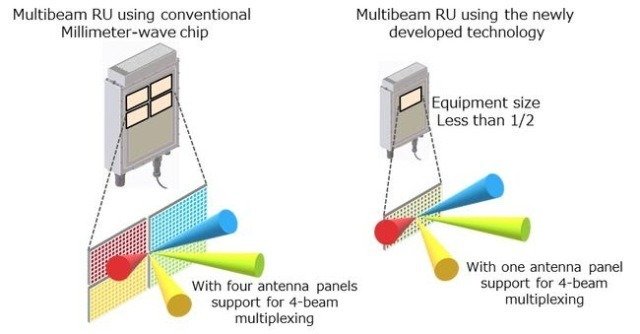In a significant stride towards enhancing 5G network capabilities, Fujitsu has announced the successful development of an innovative millimeter-wave chip that supports multibeam multiplexing for 5G base station radio units (RUs).
 This technological advancement enables the multiplexing of up to four beams using a single millimeter-wave chip, marking a substantial leap in efficiency and performance for 5G communication systems. The breakthrough was achieved as part of the “Research and Development Project of the Enhanced Infrastructures for Post-5G Information and Communication Systems,” a collaborative effort with Japan’s New Energy and Industrial Technology Development Organization (NEDO).
This technological advancement enables the multiplexing of up to four beams using a single millimeter-wave chip, marking a substantial leap in efficiency and performance for 5G communication systems. The breakthrough was achieved as part of the “Research and Development Project of the Enhanced Infrastructures for Post-5G Information and Communication Systems,” a collaborative effort with Japan’s New Energy and Industrial Technology Development Organization (NEDO).
Traditionally, a solitary millimeter-wave chip was responsible for generating a single communication beam, leading to larger and more power-intensive radio units. Fujitsu’s groundbreaking innovation revolutionizes this approach. Through the integration of multibeam multiplexing technology, the company demonstrated that 10Gbps or higher-speed communication is achievable with radio units half the size of conventional ones. By substantially reducing the number of required millimeter-wave chips, power consumption per radio unit can be slashed by an impressive 30 percent.
Project Background
The pursuit of faster speeds and higher capacity in 5G networks has prompted the exploration of millimeter-wave frequencies. However, these high-frequency waves face challenges in propagating over long distances due to their susceptibility to obstructions. Fujitsu’s ingenious solution involves deploying a larger number of radio base stations to address this hurdle, resulting in miniaturized radio units, energy savings, and cost reductions. Over a three-year period, Fujitsu collaborated with NEDO to refine this approach and succeeded in developing a technology capable of multibeam multiplexing via millimeter-wave beamforming. This achievement translates to four times the speed and greater capacity compared to conventional radio units of similar dimensions, promising significant energy efficiency and cost-effectiveness.
Future Prospects
Fujitsu’s plans for the future are ambitious and promising. The company is set to commence the development of base station hardware equipped with this groundbreaking technology in August 2023. The commercial deployment of radio units utilizing this technology is slated to begin on a global scale in fiscal year 2024. By doing so, Fujitsu aims to drive the adoption of millimeter-wave technology in the global market and contribute to the telecom industry’s efforts towards decarbonization.
Fujitsu said the cutting-edge beam multiplexing technology will subsequently be incorporated into base station (CU/DU) products, with global availability planned for fiscal year 2025. As a result, telecommunication carriers and commercial users can anticipate a reduction in their carbon footprint, while Fujitsu continues to lead advancements in network technologies and accelerate the rollout of next-generation communication infrastructure.
